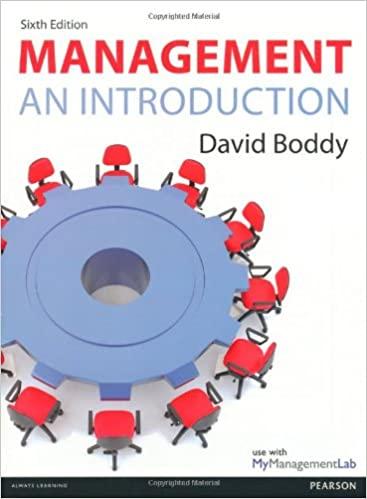Question
Short Answer Questions 2.What are the challenges created by the key trends and issues impacting health care and recreation therapy/therapeutic recreation worldwide? 3. Describe the
Short Answer Questions
2.What are the challenges created by the key trends and issues impacting health care and recreation therapy/therapeutic recreation worldwide?
3. Describe the settings where first-line managers are employed and the clientele with whom first-line managers work.
4.Identify and describe five management skills. Do all managers need these skills?
5.Identify and explain the four functions of management. Do all managers perform all four functions?
6.Is it more important for a manager to be efficient or effective? Can you be both?
7.What are the major types of resources managers oversee? And for each, what are examples of the manager's responsibilities?
8.What are the challenges faced when a practitioner moves into a first-line management position?
9.What is the relationship between organizational stress and burnout? What responsibilities does the manager assume in the management of stress?
Multiple Choices
10.How has management been defined?
a.Achieving goals.
b.Getting things done through other people.
c.Coordinating activities.
d.Effective supervision of people.
11.Which term describes the designated area of the organization over which a manager has charge or control?
a.Competency
b.Hierarchy
c.Responsibility
d.Authority
12.Which administrative function is foundational to each of the other functions?
ACommunication
BDecision making
COrganizing
DPlanning
13.What is an example of a manager's controlling function?
aMonitoring the budget.
bWriting program evaluations.
cDesigning new client programs.
dDelegating project assignments within the department.
14.Which statement best defines authority?
a.The right to give directives or make decisions in the organization.
bThe right to use power in the organization.
cThe responsibility to delegate work assignments.
dThe right to control the organization.
15.What are typical responsibilities of practitioners?
aAssigning resources and responsibilities.
bShort-term planning in the organization.
cCarrying out the day-to-day operations and services of the organization.
dPurchasing and inventory management.
16.Which of the following is an example of informal authority?
aCommunicating a work assignment in a verbal exchange, rather than in writing.
bUsing leadership skills to cause a practitioner to act willingly to complete a task.
cWorking collaboratively with a practitioner to complete a job task.
dVolunteering to take responsibility for an important project.
17.Which statement identifies an important balance maintained by managers?
a.Individual competencies, job demands, and the organizational environment.
b.Team competencies, job tasks, and job stresses.
c.Organizational demands, job skills, and team competencies.
d.Individual competencies, job stress, and technical skills.
18.Which of the following is NOT considered a common challenge as a practitioner moves into a first-line manager position?
a.The first-line therapeutic recreation manager may experience frustrations a bureaucratic environment that operates under well-defined procedures.
bFirst-line managers typically need a higher level of technical skills than practitioners.
cRelationships with colleagues are influenced by the transition from practitioner to first-line manager.
d.One of the most challenging situations managers encounter in their first management position is exercising authority over former colleagues.
19.Today's fast-paced and every-changing environment contributes to managers' stress.Which of the following best describes possible results of their stress?
aStress causes physical, psychological, and behavioral symptoms.
bManagers who manage their time do not experience significant stress.
cSome stress is necessary to encourage motivation and productivity.
cAs personal competencies increase, the manager's stress tends to decrease.
20.What are the three levels of management found in the health and human services?
aTechnical, conceptual, interpersonal
bLeader, manager, practitioner
cCEO, department head, supervisor
dLeader, planner, controller
21.What are the three levels of management found in the health and human services?
aTechnical, conceptual, interpersonal
bLeader, manager, practitioner
cCEO, department head, supervisor
dLeader, planner, controller
22. What is a primary contributor to the rapid rate of change in health care?
a.education
b.research
c.globalization
d.technology
23. What is a challenge that results from the trend to focus on holistic patient-centered care?
a.creating access to care for all clients
b.assuring quality of client care
c.documenting outcomes of specific interventions
d.engaging in interdisciplinary cooperation
24. Where do the majority of CTRSs practice in the United States?
a.hospitals and skilled care centers
b.residential centers
c.community parks and recreation
d.outpatient and day treatment programs
25. What is the primary responsibility of a first-line manager?
a.supervises volunteers and interns
b.ensures clients are engaged in quality programs
c.develops budgets and raises operational funds
d.selects interventions based on evidence-based practices
26. What is an essential quality unique to a first-line management position?
a.understanding various types of budgets
b.preparing quality improvement plans
c.awareness of the interdependency of organizational entities
d.competency in human relations training and development
Step by Step Solution
There are 3 Steps involved in it
Step: 1

Get Instant Access to Expert-Tailored Solutions
See step-by-step solutions with expert insights and AI powered tools for academic success
Step: 2

Step: 3

Ace Your Homework with AI
Get the answers you need in no time with our AI-driven, step-by-step assistance
Get Started


